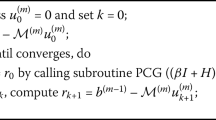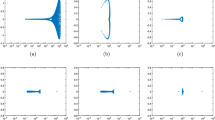Abstract
In this paper, preconditioned conjugate gradient (PCG) method with Strang’s circulant preconditioner is investigated to solve the Hermitian positive definite linear systems, which is result from the Crank–Nicolson (C-N) finite difference scheme with the weighted and shifted Grünwald difference (WSGD) operators to discretize the Riesz space fractional advection–dispersion equation (RSFADE). We show that the spectrum of the preconditioned matrix is clustered around 1, and the singular values of the preconditioned matrix are uniformly bounded away from zero under a certain condition, respectively; hence the PCG method, when applied to solving the preconditioned system, converges superlinearly. Moreover, the complexity in each iteration of the PCG method is \(O(N\log N)\) via using the fast Fourier transforms, where N is the matrix size. Numerical experiments are included to demonstrate the effectiveness of our approach.
Similar content being viewed by others

References
Bai J, Feng X (2007) Fractional-order anisotropic diffusion for image denoising. IEEE Trans Image Proc 16:2492–2502
Benson D, Wheatcraft SW, Meerschaert MM (2000a) Application of a fractional advection–dispersion equation. Water Resour Res 36:1403–1413
Benson D, Wheatcraft SW, Meerschaert MM (2000b) The fractional-order governing equation of Lévy motion. Water Resour. Res 36:1413–1423
Carella AR, Dorao CA (2013) Least-squares spectral method for the solution of a fractional advection–dispersion equation. J Comput Phys 232:33–45
Carreras BA, Lynch VE, Zaslavsky GM (2001) Anomalous diffusion and exit time distribution of particle tracers in plasma turbulence models. Phys Plasma 8:5096–5103
Çelik C, Duman M (2012) Crank–Nicolson method for the fractional diffusion equation with the Riesz fractional derivative. J Comput Phys 231:1743–1750
Chan R, Jin XQ (2007) An introduction to iterative Toeplitz solvers. SIAM, Philadelphia
Chan R, Ng MK (1996) Conjugate gradient methods for Toeplitz systems. SIAM Rev 38:427–482
Chan R, Strang G (1989) Toeplitz equations by conjugate gradients with circulant preconditioner. SIAM J Sci Stat Comput 10:104–119
Chen W, Holm S (2004) Fractional Laplacian time-space models for linear and nonlinear lossy media exhibiting arbitrary frequency dependency. J Acoust Soc Am 115(4):1424–1430
Chen W, Pang GF (2016) A new definition of fractional Laplacian with application to modeling three-dimensional nonlocal heat conduction. J Comput Phys 309(15):350–367
Chen W, Hu S, Cai W (2016) A causal fractional derivative model for acoustic wave propagation in lossy media. Arch Appl Mech 86(3):529–539
Chen W, Fang J, Pang GF, Holm S (2017) Fractional biharmonic operator equation model for arbitrary frequency-dependent scattering attenuation in acoustic wave propagation. J Acoust Soc Am 141(1):244–253
Chou LK, Lei SL (2016) Fast ADI method for high dimensional fractional diffusion equations in conservative form with preconditioned strategy. Comput Math Appl 73(3):385–403
Ding HF, Li CP (2016) High-order algorithms for Riesz derivative and their applications (III). Fract Calc Appl Anal 19:19–55
Ding HF, Li CP, Chen YQ (2014) High-order algorithms for Riesz derivative and their applications (I). Abstr Appl Anal 17. https://doi.org/10.1155/2014/653797
Ding HF, Li CP, Chen YQ (2015) High-order algorithms for Riesz derivative and their applications (II). J Comput Phys 293:218–237
Ervin VJ, Roop JP (2006) Variational formulation for the stationary fractional advection–dispersion equation. Numer Methods Partial Differ Equ 22:558–576
Feng LB, Zhuang PH, Liu FW, Turner I, Li J (2016) High-order numerical methods for the Riesz space fractional advection–dispersion equations. Comput Math Appl. https://doi.org/10.1016/j.camwa.2016.01.015
Golbabai A, Sayevand K (2011) Analytical modelling of fractional advection–dispersion equation defined in a bounded space domain. Math Comput Model 53:1708–1718
Hejazi H, Moroney T, Liu FW (2014) Stability and convergence of a finite volume method for the space fractional advection–dispersion equation. J Comput Appl Math 255:684–697
Horn RA, Johnson CR (1991) Topic in matrix analysis. Cambridge University Press, Cambridge
Huang FH, Liu FW (2005) The fundamental solution of the space-time fractional advection–dispersion equation. J Appl Math Comput 18(1–2):339–350
Jin XQ, Lin FR, Zhao Z (2015) Preconditioned iterative methods for two-dimensional space-fractional diffusion equations. Commun Comput Phys 18(2):469–488
Lei SL, Sun HW (2013) A circulant preconditioner for fractional diffusion equations. J Comput Phys 242:715–725
Lei SL, Chen X, Zhang XH (2016) Multilevel circulant preconditioner for high-dimensional fractional diffusion equations. East Asian J Appl Math 6(2):109–130
Lin FR, Yang SW, Jin XQ (2014) Preconditioned iterative methods for fractional diffusion equation. J Comput Phys 256:109–117
Liu FW, Anh V, Turner I, Zhuang PH (2003) Time fractional advection–dispersion equation. J Appl Math Comput 13(1–2):233–246
Liu FW, Zhuang PH, Anh V, Turner I, Burra K (2007a) Stability and convergence of the difference methods for the space-time fractional advection–diffusion equation. Appl Math Comput 191:12–20
Liu QX, Liu FW, Turner I, Anh V (2007b) Approximation of the Levy–Feller advection–dispersion process by random walk and finite difference method. J Comput Phys 222(1):57–70
Magin RL (2006) Fractional calculus in bioengineering. Begell House Publishers, New York
Meerschaert MM, Tadjeran C (2004) Finite difference approximations for fractional advection–dispersion flow equations. J Comput Appl Math 172:65–77
Meerschaert MM, Tadjeran C (2006) Finite difference approximations for two-sided space-fractional partial differential equations. Appl Numer Math 56:80–90
Metzler R, Klafter J (2000) The random walks guide to anomalous diffusion: a fractional dynamics approach. Phys Rep 339:1–77
Pan JY, Ke RH, Ng MK, Sun HW (2014) Preconditioning techniques for diagonal-times-Toeplitz matrices in fractional diffusion equations. SIAM J Sci Comput 36:A2698–A2719
Pang HK, Sun HW (2012) Multigrid method for fractional diffusion equations. J Comput Phys 231:693–703
Pang HK, Sun HW (2016) Fast numerical contour integral method for fractional diffusion equations. J Sci Comput 66:41–66
Qu W, Lei SL, Vong SW (2014) Circulant and skew-circulant splitting iteration for fractional advection–diffusion equations. Int J Comput Math 91:2232–2242
Raberto M, Scalas E, Mainardi F (2002) Waiting-times and returns in high-frequency financial data: an empirical study. Physica A 314:749–755
Ran YH, Wang JG (2016) On ADI-like iteration method for fractional diffusion equations. Linear Algebra Appl 493:544–555
Saichev AI, Zaslavsky GM (1997) Fractional kinetic equations: solutions and applications. Chaos 7:753–764
Shen SJ, Liu FW, Anh V, Turner I (2008) The fundamental solution and numerical solution of the Riesz fractional advection–dispersion equation. IMA J Appl Math 73(6):850–872
Shen SJ, Liu FW, Anh V (2011) Numerical approximations and solution techniques for the space-time Riesz–Caputo fractional advection–diffusion equation. Numer Algorithms 56:383–403
Shlesinger MF, West BJ, Klafter J (1987) Lévy dynamics of enhanced diffusion: application to turbulence. Phys Rev Lett 58:1100–1103
Sousa E (2009) Finite difference approximates for a fractional advection diffusion problem. J Comput Phys 228:4038–4054
Sousa E, Li C (2015) A weighted finite difference method for the fractional diffusion equation based on the Riemann–Liouville derivative. Appl Numer Math 90:22–37
Tian WY, Zhou H, Deng WH (2015) A class of second order difference approximation for solving space fractional diffusion equations. Math Comput 84:1703–1727
Wang H, Du N (2013) A fast finite difference method for three-dimensional time-dependent space-fractional diffusion equations and its efficient implementation. J Comput Phys 253:50–63
Wang H, Du N (2014) Fast alternating-direction finite difference methods for three-dimensional space-fractional diffusion equations. J Comput Phys 258:305–318
Wang KQ, Wang H (2011) A fast characteristic finite difference method for fractional advection–diffusion equations. Adv Water Resour 34:810–816
Wang WF, Chen X, Ding D, Lei SL (2015a) Circulant preconditioning technique for barrier options pricing under fractional diffusion models. Int J Comput Math 92(12):2596–2614
Wang XB, Liu FW, Chen XJ (2015b) Novel second-order accurate implicit numerical methods for the Riesz space distributed-order advection-dispersion equations. Adv Math Phys. 14. https://doi.org/10.1155/2015/590435
Zaslavsky GM (2002) Chaos, fractional kinetics, and anomalous transport. Phys Rep 371:461–580
Zhang L, Sun HW, Pang HK (2015) Fast numerical solution for fractional diffusion equations by exponential quadrature rule. J Comput Phys 299:130–143
Acknowledgements
The authors would like to convey their thanks to the anonymous referees and the associate editor for their very helpful comments and suggestions, which greatly improved this paper.
Author information
Authors and Affiliations
Corresponding author
Additional information
Communicated by José Tenreiro Machado.
Wei Qu is supported by the National Natural Science Foundation of China (Grant No. 11601340). Yong Liang is supported by the National Natural Science Foundation of China (Grant No. 61661166011), and Macau Science and Technology Development Fund (FDCT) 003/2016/AFJ.
Rights and permissions
About this article
Cite this article
Qu, W., Shen, HW. & Liang, Y. PCG method with Strang’s circulant preconditioner for Hermitian positive definite linear system in Riesz space fractional advection–dispersion equations. Comp. Appl. Math. 37, 4554–4569 (2018). https://doi.org/10.1007/s40314-018-0586-6
Received:
Revised:
Accepted:
Published:
Issue Date:
DOI: https://doi.org/10.1007/s40314-018-0586-6
Keywords
- Preconditioned conjugate gradient method
- Riesz space fractional advection–dispersion equation
- Crank–Nicolson finite difference scheme
- Strang’s circulant preconditioner
- Fast Fourier transforms



